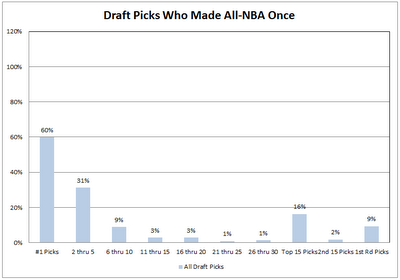- A player must have played 33 games with one team during the season
- A player must have ranked in the top 40 of shots per game
1. Kevin Durant. Last year, I was basically obnoxious in pointing out the fact that while Durant won his 2nd straight scoring title, he wasn't quite the most efficient scorer. Well, that is no longer the case. Not only did Durant win his 3rd straight scoring title, he beat out Kobe Bryant despite taking 3+ fewer shots per game.
2. Joe Johnson. The easiest max deal in the world to make fun of, it seems like this year Joe may have lived up to his salary. Good sign of things to come for Hawks fans? Probably not. This was only his second season cracking 1.00 points per shot, the other coming in his first (and only) season with Steve Nash and the "7 Seconds or Less" Suns. So, congratulations... it took seven years and two contracts to get the Joe Johnson from 2005, but you (almost) got it this year.
3. Lebron James. Career high scoring efficiency, the best talent in the game for a few years running. If the MVP could be split into the "Michael Jordan Award" (best player in the game) and "Bill Russell Award" (most valuable cog to a team), Lebron would win the "Jordan" in a landslide every year, and we could focus our time on debating the "Russell" winner (Chris Paul or Ricky Rubio, in my opinion).
4. Kyrie Irving. In all honesty, as a Bobcats fan, I was more interested in the 2012 lottery than the 2011 lottery, because I wasn't sure Irving was all that great. Turns out, he's really crafty at both getting to the rim and finishing through contact. Now, while he may not be able to improve those skills that much, he doesn't need to - he's already elite at that. Great building block for Cleveland.
5. Chris Paul. Last year in New Orleans, Chris Paul was a one man crunch time offense. This year as a Clipper? He's a one man crunch time offense. It's obviously a work in progress, and it's not Paul's fault, but the Clippers have been a little disappointing to this point.
Other Notable Finds...
- Andrew Bynum (0.99 PPS on 7 more shots per game) didn't seem like fair compensation for Dwight Howard, but it's getting harder to argue. If this is what we'll get out of him for the next 5 years, the top 2 centers in the league are set in stone.
- Blake Griffin got a lot better on 2 point field goals in 2012, but his free throw percentage somehow got even worse than his rookie year. Until that gets above 70%, he'll have to remain a relative spectator in the last 5 minutes of close games on offense.
- If James Harden had taken about 1 more shot per game, he would have won the title of league's best scorer at 1.046 points per shot. After last year's Mavericks series, I tried to warn Thunder fans about expecting him to sustain that level of offensive production for a whole season. Well, he basically did, and everyone who thought Tyreke Evans and Stephen Curry were better fits should lay low for a while.
- For everyone who thinks that Kobe Bryant's inefficient shooting will doom the Lakers in the playoffs, a bit of history: this year, Kobe took 30.8 shots per game and scored .904 points per shot. In '97-98, Michael Jordan took 31.9 shots per game and scored .902 points per shot. In the playoffs that spring, MJ took 35.7 shots per game and scored .908 points per shot. Are any of those numbers good? Not really. But the Bulls still managed to win a title that year. So if by the end of June, we're watching shocked as the Lakers hang another banner despite Kobe's poor shooting, we should probably remember: it's been done before.








